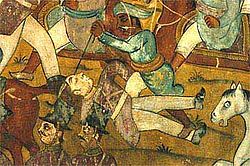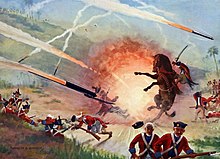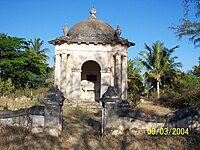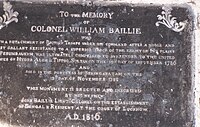27th AUGUST 1781 BATTLE OF POLLILUR FOUGHT BETWEEN HYDER ALI AND BRITISH EAST INDIA COMPANY
Battle of Pollilur (1781)
From Wikipedia, the free encyclopedia
| ||||||||||||||||||||||||||||
| ||||||||||||||||||||||||||||
The Battle of Pollilur was fought on 27 August 1781, between forces of the Kingdom of Mysore under Hyder Ali and British East India Company forces led by General Eyre Coote. The battle was fought on the site of a 1780 encounter in which a Company force was almost completely killed or captured.
In the 1781 battle, the company's army was organized into 2 lines. One line fought against the troops under Tipu. But Hyder Ali's army faced severe casualties and retreated to Kanchipuram.
After the battle a shortage of provisions led Coote to move his forces toward Tripasur.[4] Hyder interpreted this as a retreat, and claimed victory.[citation needed]
References[edit]
Bibliography[edit]
- Roy, Kaushik. War, Culture, Society in Early Modern South Asia, 1740-1849. Routledge, 2011.
- Vibart, H. M (1881). The military history of the Madras engineers and pioneers, from 1743 up to the present time, Volume 1
| This article about a battle in British history is a stub. You can help Wikipedia by expanding it. |
| This Indian history-related article is a stub. You can help Wikipedia by expanding it. |
Battle of Pollilur (1780)
From Wikipedia, the free encyclopedia
This article is about the 1780 battle. For the 1781 battle, see Battle of Pollilur (1781).
| This article needs additional citations for verification. (January 2009) |
| ||||||||||||||||||||||||||||||
| ||||||||||||||||||||||||||||||
The Battle of Pollilur, also known as the Battle of Polilore or Battle of Perambakam, took place on 10 September 1780 at Pollilur near the city of Kanchipuram in present-day Tamil Nadu state, India as part of the Second Anglo-Mysore War. It was waged between two forces commanded by Tipu Sultan of the Kingdom of Mysore, and Colonel William Baille of the British East India Company. The army of the East India Company surrendered and suffered a high number of casualties. It was the worst loss the British suffered on the subcontinent until Chillianwala.
Contents
[hide]Aftermath[edit]
Baille and many of his officers were captured and taken to the Mysore capital at Srirangapattana. After British reinforcements from Calcutta arrived, Eyre Coote was able to stabilise the situation and counter-attack. A second battle was fought a year later in the same area where Coote defeated Haider Ali's forces.
Rockets[edit]
The Mysore rockets used during the battle were much more advanced than the British East India Company had previously seen, chiefly because of the use of iron tubes for holding the propellant; this enabled higher thrust and longer range for the missile (up to 2 km range). After Tipu Sultan's eventual defeat in theFourth Anglo-Mysore War and the capture of the Mysore iron rockets, they were influential in British rocket development, inspiring the Congreve rocket, which was soon put into use in the Napoleonic Wars.[5]
See also[edit]
Gallery[edit]
External links[edit]
- ^ Gott, Richard (2000). Britain's Empire: Resistance, Repression and Revolt. London: Verso Books. p. 76. ISBN 1-84467-738-9. Retrieved 8 February 2012.
- ^ a b Dalrymple, William (1 October 2005). "ASSIMILATION AND TRANSCULTURATION IN EIGHTEENTH-CENTURY INDIA: A Response to Pankaj Mishra". Common Knowledge 11 (3): 445–485. doi:10.1215/0961754X-11-3-445. Retrieved 8 February 2012.
As late as 1780, following the disastrous British defeat by Tipu Sultan of Mysore at the Battle of Pollilur, 7,000 British men, along with an unknown number of women, were held captive by Tipu in his sophisticated fortress of Seringapatam.
- ^ Jaim, H M Iftekhar; Jaim, Jasmine (1 October 2011). "The Decisive Nature of the Indian War Rocket in the Anglo-Mysore Wars of the Eighteenth Century". Arms & Armour 8 (2): 131–138. doi:10.1179/174962611X13097916223244. Retrieved 8 February 2012.
Captain Munro noted: 'Around two or three thousand horse and rocket-men kept hovering round our main army, in order to conceal his enterprise from us'.
- ^ a b Jasanoff, Maya (2005). Edge of empire: lives, culture, and conquest in the East, 1750-1850 (1. ed.). New York: Knopf. p. 157. ISBN 1-4000-4167-8.
Some three thousand Company soldiers were killed, while Baillie and two hundred Europeans, fifty of them officers, were carried off to Seringapatam in chains.
- ^ Roddam Narasimha (1985). Rockets in Mysore and Britain, 1750-1850 A.D. National Aeronautical Laboratory and Indian Institute of Science.
- Tipu Sultan website
- Wilson, W. J. History of the Madras Army, Volume 2
Search Results
Tipu Sultan - Tiger of Mysore - Indian History in Rocketry ...
www.youtube.com/watch?v=21LjHkzD1BQ
Aug 21, 2008 - Uploaded by Radio Malayalam
Thereafter from 1750 AD to 1799 AD Haider Ali and Tipu Sultan (Sultan of ... Battle of Pollilur - Mysore state ...The History Of The Anglo-Mysore Wars - YouTube
www.youtube.com/watch?v=zMH4YjLQK5w
May 30, 2015 - Uploaded by MadeInTurkey
Hyder Ali's alliance with the Nizam of Hyderabad against theBritish too ... The Mysorean rockets used by ...Tipu's Tiger - Part 1 - YouTube
www.youtube.com/watch?v=lKq5CqxcQ90
Oct 21, 2009 - Uploaded by djamaluddin
Tippoo's father, Haider Ali, a commander-in-chief who had usurped the throne of ... The ensuing battle of ...Daria Daulat, The Palace of Tipu Sultan - YouTube
www.youtube.com/watch?v=UlEpeqUVRdo
Jul 26, 2014 - Uploaded by WildFilmsIndia
Bailee in the battle of Pollilur near Kanchipuram in 1780. ... he armies led by Haider Ali and Tippu Sultan ...Tippoo's Tiger on Vimeo
vimeo.com › Victoria and Albert Museum › Videos
Nov 3, 2010
Tippoo's father, Hyder Ali, a commander-in-chief who had usurped the throne of ... The ensuing battle of ...Daria Daulat : Tipu Sultan's summer palace at ... - Dailymotion
www.dailymotion.com/.../x23f46w_daria-daulat-tip...
Aug 12, 2014
Bailee in the battle of Pollilur near Kanchipuram in 1780. ... he armies led by Haider Ali and Tippu Sultan ...TIPU SULTAN FINAL BATTLE - YouTube
www.youtube.com/watch?v=XRy4g-l9g9Y
Jan 2, 2010 - Uploaded by Anwar Bhutaa
Tipu Sultan, the eldest son of Haider Ali, was born on December 10, 1750 at ... As long as the British fought ...Daria Daulat, The Palace of Tipu Sultan - Video Dailymotion
www.dailymotion.com/.../x23f4cb_daria-daulat-the-pa...
Aug 12, 2014
Bailee in the battle of Pollilur near Kanchipuram in 1780. ... he armies led by Haider Ali and Tippu Sultan ...Daria Daulat : Tipu Sultan's summer palace at ...
www.youtube.com/watch?v=QZOBloWCcsQ
Jul 29, 2014 - Uploaded by WildFilmsIndia
Bailee in the battle of Pollilur near Kanchipuram in 1780. ... he armies led by Haider Ali and Tippu Sultan ...Tipu Sultans victorious battle against the Bandit British ...
www.youtube.com/watch?v=OkGOy5YtKK0
Nov 25, 2007 - Uploaded by Asimrauf78
He helped his father Haidar Ali defeat the British in the Second Mysore War, and negotiated the Treaty of ...
Stay up to date on results for haider ali and the britishers battle of pollilur.
Create alert
Showing results for haider ali and the britishers battle of pollilur
Search instead for haider ali and the britishers battle of pallilore
Search instead for haider ali and the britishers battle of pallilore
Search Results
Battle of Pollilur (1780) - Wikipedia, the free encyclopedia
https://en.wikipedia.org/wiki/Battle_of_Pollilur_(1780)
Flag of the British East India Company (1707).svg ... The Battle of Pollilur, where the forces of Hyder Ali effectively used Mysorean rockets and rocket artillery ...Battle of Pollilur (1781) - Wikipedia, the free encyclopedia
https://en.wikipedia.org/wiki/Battle_of_Pollilur_(1781)
The Battle of Pollilur was fought on 27 August 1781, between forces of the Kingdom of Mysore under Hyder Ali and British East India Company forces led bySecond Anglo-Mysore War - Wikipedia, the free encyclopedia
https://en.wikipedia.org/wiki/Second_Anglo-Mysore_War
At the time, Mysore was a key French ally in India, and the Franco–British war ... TheBattle of Pollilur, where the forces of Hyder Ali effectively used Mysorean ...Hyder Ali - Wikipedia, the free encyclopedia
https://en.wikipedia.org/wiki/Hyder_Ali
He concluded an alliance with the French against the British, and used the ..... TheBattle of Pollilur, where the forces of Hyder Ali effectively used Mysorean ...Anglo-Mysore Wars - Wikipedia, the free encyclopedia
https://en.wikipedia.org/wiki/Anglo-Mysore_Wars
Hyder Ali's alliance with the Nizam of Hyderabad against the British too was a failure ... The Mysorean rockets used by Hyder Ali during the Battle of Pollilur were ...Concise History of Islam - Page 263 - Google Books Result
https://books.google.co.in/books?isbn=938257347X
Haider Ali had some initial successes against the British notably at Pollilur, the ... the first heavy blow against Haider Ali in the decisive Battle of Porto Novo.Painting of the Battle of Pollilur 1780 British defeat in India
https://www.battle-of-pollilur-painting.com/
Commemorating his father Haidar Ali who died during the 2nd Anglo Mysore WarHyder Ali | biography - emperor of India | Britannica.com
www.britannica.com/biography/Hyder-Ali
Hyder Ali, also spelled Haidar Ali (born 1722, Budikote, Mysore [India]—died December 7, ... In 1766 the Marathas, ʿAlī Khān, nizam of Hyderabad, and the British... at the battles of Porto Novo, Pollilur, and Sholinghur; Hyder lost more than ...3.8 The Battle of Pollilur 1780, D/ Halidar Ali and Tipu Sultan
www.tigerandthistle.net/tipu38.htm
3.8 The Battle of Pollilur 1780: D/ Halidar Ali and Tipu Sultan ... less resistance, but when Haidar was informed that the British next intended to attack Mahe, ...Tipu Sultan - Tiger of Mysore - Indian History in Rocketry ...
www.youtube.com/watch?v=21LjHkzD1BQ
Aug 21, 2008 - Uploaded by Radio Malayalam
Thereafter from 1750 AD to 1799 AD Haider Ali and Tipu Sultan (Sultan of ... Battle of Pollilur - Mysore state ...
Kharghar, Navi Mumbai, Maharashtra - From your Internet address - Use precise location











No comments:
Post a Comment